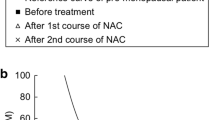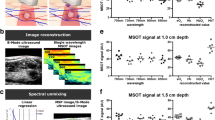Abstract
Background
Optical imaging and spectroscopy using near-infrared light have great potential in the assessment of tumor vasculature. We previously measured hemoglobin concentrations in breast cancer using a near-infrared time-resolved spectroscopy system. The purpose of the present study was to evaluate the effect of the chest wall on the measurement of hemoglobin concentrations in normal breast tissue and cancer.
Methods
We measured total hemoglobin (tHb) concentration in both cancer and contralateral normal breast using a near-infrared time-resolved spectroscopy system in 24 female patients with breast cancer. Patients were divided into two groups based on menopausal state. The skin-to-chest wall distance was determined using ultrasound images obtained with an ultrasound probe attached to the spectroscopy probe.
Results
The apparent tHb concentration of normal breast increased when the skin-to-chest wall distance was less than 20 mm. The tHb concentration in pre-menopausal patients was higher than that in post-menopausal patients. Although the concentration of tHb in cancer tissue was statistically higher than that in normal breast, the contralateral normal breast showed higher tHb concentration than cancer in 9 of 46 datasets. When the curves of tHb concentrations as a function of the skin-to-chest wall distance in normal breast were applied for pre- and post-menopausal patients separately, all the cancer lesions plotted above the curves.
Conclusions
The skin-to-chest wall distance affected the measurement of tHb concentration of breast tissue by near-infrared time-resolved spectroscopy. The tHb concentration of breast cancer tissue was more precisely evaluated by considering the skin-to-chest wall distance.







Similar content being viewed by others
References
Cerussi A, Shah N, Hsiang D, Durkin A, Butler J, Tromberg BJ. In vivo absorption, scattering, and physiologic properties of 58 malignant breast tumors determined by broadband diffuse optical spectroscopy. J Biomed Opt. 2006;11:044005. doi:10.1117/1.2337546.
Srinivasan S, Pogue BW, Brooksby B, Jiang S, Dehghani H, Kogel C, et al. Near-infrared characterization of breast tumors in vivo using spectrally-constrained reconstruction. Technol Cancer Res Treat. 2005;4:513–26.
Grosenick D, Moesta KT, Wabnitz H, Mucke J, Stroszczynski C, Macdonald R, et al. Time-domain optical mammography: initial clinical results on detection and characterization of breast tumors. Appl Opt. 2003;42:3170–86.
Pogue BW, Poplack SP, McBride TO, Wells WA, Osterman KS, Osterberg UL, et al. Quantitative hemoglobin tomography with diffuse near-infrared spectroscopy: pilot results in the breast. Radiology. 2001;218:261–6. doi:10.1148/radiology.218.1.r01ja51261.
Xu C, Zhu Q. Estimation of chest-wall-induced diffused wave distortion with the assistance of ultrasound. Appl Opt. 2005;44:4255–64.
Ardeshirpour Y, Huang M, Zhu Q. Effect of the chest wall on breast lesion reconstruction. J Biomed Opt. 2009;14:044005. doi:10.1117/1.3160548.
Suzuki K, Yamashita Y, Ohta K, Kaneko M, Yoshida M, Chance B. Quantitative measurement of optical parameters in normal breasts using time-resolved spectroscopy: in vivo results of 30 Japanese women. J Biomed Opt. 1996;1:330–4. doi:10.1117/12.239902.
Leff DR, Warren OJ, Enfield LC, Gibson A, Athanasiou T, Patten DK, et al. Diffuse optical imaging of the healthy and diseased breast: a systematic review. Breast Cancer Res Treat. 2008;108:9–22. doi:10.1007/s10549-007-9582-z.
Patterson MS, Chance B, Wilson BC. Time resolved reflectance and transmittance for the non-invasive measurement of tissue optical properties. Appl Opt. 1989;28:2331–6. doi:10.1364/ao.28.002331.
Ueda S, Nakamiya N, Matsuura K, Shigekawa T, Sano H, Hirokawa E, et al. Optical imaging of tumor vascularity associated with proliferation and glucose metabolism in early breast cancer: clinical application of total hemoglobin measurements in the breast. BMC Cancer. 2013;13:514. doi:10.1186/1471-2407-13-514.
O’Connor DV, Phillips D. Data analysis. In: O’Connor DV, Phillips D, editors. Time-correlated single photon counting. London: Academic Press; 1984. p. 158–210.
Yamamoto K. Measurement of dynamic change in muscle oxygenation using near-infrared spectroscopy. J Jpn Soc Stomatognath Funct. 2006;12:93–9.
Spinelli L, Torricelli A, Pifferi A, Taroni P, Danesini GM, Cubeddu R. Bulk optical properties and tissue components in the female breast from multiwavelength time-resolved optical mammography. J Biomed Opt. 2004;9:1137–42. doi:10.1117/1.1803546.
Shah N, Cerussi A, Eker C, Espinoza J, Butler J, Fishkin J, et al. Noninvasive functional optical spectroscopy of human breast tissue. Proc Natl Acad Sci USA. 2001;98:4420–5. doi:10.1073/pnas.071511098.
Cerussi AE, Berger AJ, Bevilacqua F, Shah N, Jakubowski D, Butler J, et al. Sources of absorption and scattering contrast for near-infrared optical mammography. Acad Radiol. 2001;8:211–8. doi:10.1016/s1076-6332(03)80529-9.
Shah N, Cerussi AE, Jakubowski D, Hsiang D, Butler J, Tromberg BJ. Spatial variations in optical and physiological properties of healthy breast tissue. J Biomed Opt. 2004;9:534–40. doi:10.1117/1.1695560.
Nakamiya N, Ueda S, Shigekawa T, Takeuchi H, Sano H, Hirokawa E, et al. Clinicopathological and prognostic impact of imaging of breast cancer angiogenesis and hypoxia using diffuse optical spectroscopy. Cancer Sci. 2014;105:833–9. doi:10.1111/cas.12432.
Acknowledgments
This work was supported by JSPS KAKENHI Grant Numbers 25861082 and 26282144.
Author information
Authors and Affiliations
Corresponding author
Ethics declarations
Conflict of interest
The authors declare that they have no conflicts of interest.
About this article
Cite this article
Yoshizawa, N., Ueda, Y., Nasu, H. et al. Effect of the chest wall on the measurement of hemoglobin concentrations by near-infrared time-resolved spectroscopy in normal breast and cancer. Breast Cancer 23, 844–850 (2016). https://doi.org/10.1007/s12282-015-0650-7
Received:
Accepted:
Published:
Issue Date:
DOI: https://doi.org/10.1007/s12282-015-0650-7




